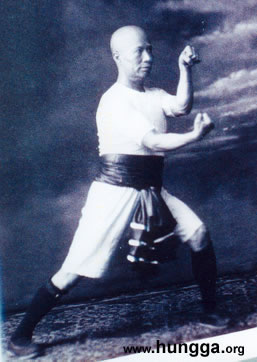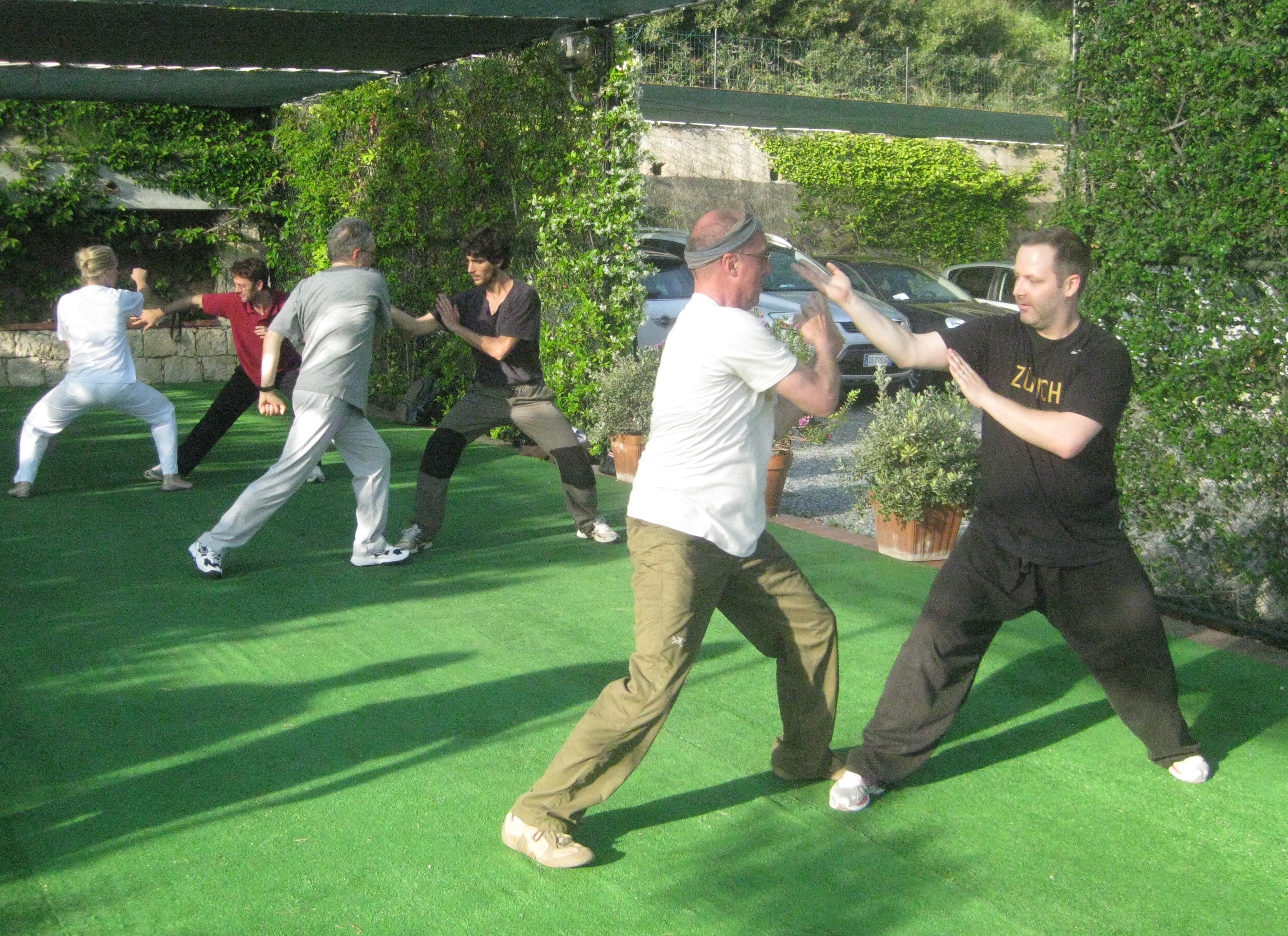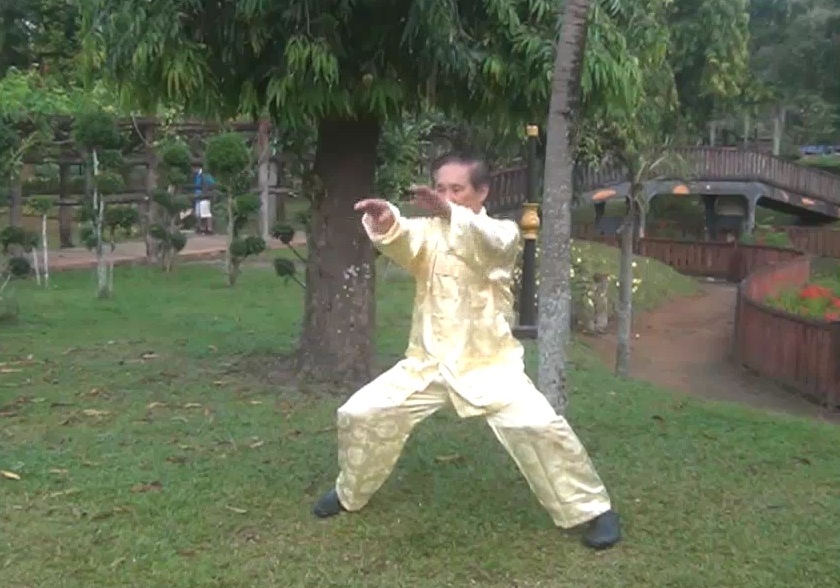THE 12 BRIDGES OF IRON WIRE IN TIGER-CRANE SET AND TAMING-TIGER SET

Grandmaster lam Sai Weng demonstrating "hard force" in the Iron Wire Set
Question 3
I am very curious about the nature of the 12 bridges of Iron Wire in application when using techniques and strategies found within the Tiger-Crane 108, and Taming the Tiger. Could you please give us some examples of how they are used?
David
Answer
The 12 bridges of Iron Wire have puzzled many people, but the puzzle can be solved when we realize that the 12 bridges refer not to 12 different types of internal force, but the same internal force used in 12 different ways.
The same problem occurs in the 8 forces of Taijiquan. It is not 8 different types of force, but the same force used in 8 different ways.
As an analogy, you have the same money from your income, but you may use your money in different ways and classify them accordingly, like food money, rent money, entertainment money, and saving money. On some occasions, you may use the money initially reserved for one category for another. For example, to make your girlfriend happy, you may take some of the money reserved for saving to entertain her.
In the same way, the force used for “lifting bridge” in Iron Wire may be used for “retaining bridge” in another occasion, or the force used for “warding off” in Taijiquan may be used for “rolling back”. But because of the different ways of force training in Iron Wire and in Taijiquan, Iron Wire force and Taijiquan force may have different characteristics. Similarly the characteristics of the income from a manager, who receive a salary at the end of the month, may be different from those of a salesman, who receives a commission when he makes a sale.
Nevertheless, because of our ability of chi flow, we can readily convert Iron Wire force to Taijiquan force, and vice versa. In the same way, a skillful manager may make adjustment so that he can use his money whenever he likes, or a skillful salesman can make adjustment to receive a large sum of money at the end of the month.
The 8 forces of Taijiquan are ward-off force, rolling-back force, pressing force, contact force, spreading force, anchor force, shoulder force and elbow force.
The 12 bridges of Iron Wire which manifest 12 types of force are hard force, soft force, pressing force, straight force, separate force, stabilizing force, inch force, lifting force, retaining force, circulating force, controlling force, and matching force.
There is a poetic couplet in Cantonese to help practitioners remember the 12 bridges as follows:
- Kong yow pik cheit fun ting chuin
- Tai lau wan chai ding thien khuen
Word by word it may be translated as follows:
- Hard soft press straight separate stable inch
- Lift keep circulate control match the cosmos
"Hard" and "soft" are generic terms that can apply to all the other types of force. In other words, pressing force can be hard or soft, straight force and be hard or soft, etc.

In the foreground Sifu Roland uses ward-off force to defect an attack from Sifu Attilio/p>
It is important to bear in mind that the classification of the 12 different types of force is to enable us to be more efficient in kungfu as well as in everyday life. It should not limit us. If we use a certain type of force in a particular pattern, it does not mean that only that force can be used in that pattern. This will be limiting ourselves, a mistake some students make. We can also use a different type of force for the same pattern. Knowing this possibility and being able to put it into practice enables us to be more proficient.
For example, hard force is usually employed in the pattern, “Black Tiger Steals Heart”. But a skillful exponent may also use soft force for this pattern. The type of hard force in “Black Tiger Steals Heart” is usually straight force. But if we want to use this pattern to press into an opponent, we may use pressing force.
With this in mind, let us examine some typical use of force, represented as the 12 bridges in the Iron Wire Set, in some of the patterns in the 108-Pattern Tiger-Crane Set and the Taming-Tiger Set. In the examples below, the first example is taken from the Tiger-Crane Set, and the second example from the Taming-Tiger Set. A picture series of the patterns of the Tiger-Crane Set can be found here and that of the Taming-Tiger Set can be found here.
Hard force is used in "Lohan Emerges from Cave" (in the Tiger-Crane Set, Picture 116) and in "Double Hanging Fists" (in the Taming-Tiger Set, Picture 54). When an opponent attempts to move away, you can press in with "Lohan Emerges from Cave". If an opponent grips your arms, you can release his grip with "False Leg Lift Fists", followed by striking him with “Double Hanging Fists”.
Soft force is found in "Right Circulating Soft Force" (Picture 31) and in "Big Boss Offers Wine" (Picture 53). "Right Circulating Soft Force" is an excellent pattern to develop soft force. When an opponent grips your wrist, you release it with a sharp turn of your hand, followed by striking him with "Big Boss Offers Wine".
Pressing Force is found in "Black Tiger Charges at Door" (Picture 37) and "Triple Stretching of Pearl Bridge" (Picture 4 in Taming Tiger). In "Black Tiger Charges at Door" you control an opponent and simultaneously press on him. "Triple Stretching of Pearl Bridge" is an excellent technique to develop pressing force.
Straight force is found in "Double Dragon Emerges from Sea" (Picture 29) and "Dark Dragon Draws Water" (Picture 48). "Double Dragon Emerges from Sea" develops straight force, and "Dark Dragon Draws Water" applies it
Separate force is found in "Cross-Road Separate Gold" (Picture 128) and "Left Right Separate Bow" (Picture 49 in Taming Tiger). If two opponents hold your arms, one on each side, you can release their holds using "Cross-Road Separate Gold". An opponent attacks you with a sophisticated technique, "Rising Dragon Galloping Tiger", striking your head and kicking you at the same time. You can respond with "Left Right Separate Bow", followed with a kick to his groin.
Stabilizing force is used in "Tame Tiger Hide Dragon" (Picture 3) and in “Double Stability of Golden Bridge" (Picture 27). "Tame Tiger Hide Dragon" is applied as a taming hand to control an opponent. "Double Stability of Golden Bridge" is an effective to develop stabilizing force.
Inch force is used in "Sink Bridge Shoot Palm" (Picture 45) and in "Continuous Pearl Punches" (Picture 95 in Taming Tiger ). As an opponent attacks your middle or lower body, you sink your forearm or elbow to intercept his attack, and counter-strike with a finger-thrust using the pattern "Sink Bridge Shoot Palm". "Continuous Pearl Punches" is a series of pressing attacks on an opponent from close-quarters.
Lifting force is found in "Immortal Emerges from Cave" (Picture 50) and "Double Bows Tame Tiger" (Picture 86 in Taming Tiger). As an opponent attempts to grip your head with his two hands, you lift them up using "Immortal Emerges from Cave". When you are in contact with an opponent’s bridge, meaning arm, lift it up at his elbow and strike him using "Double Bows Tame Tiger".
Keeping force, or retaining force, is found in "Wave Dragon Back to Cave" (Picture 10) and in "Yun Thian Tames Tiger" (Picture 49). If an opponent grips your right wrist with his left hand, you apply "Wave Dragon Back to Cave" to grip his wrist instead. As you move forward to attack your opponent, he tries to kick at you. You still move in but tame his kick using "Yun Thian Tames Tiger" while moving in.
Circulating force is found in "Bow Arrow Thread Bridge" (Picture 44) and "Horse Riding Hand Sweep" (Picture 104 in Taming Tiger). In "Bow Arrow Thread Bridge", you circulate energy to your fingers before shooting out. In "Horse Riding Hand Sweep" you circulate energy to your palm for the hand sweep.
Controlling force is found in the pattern, "Fierce Tiger Descends Mountain" (picture 98), and in "Comet Chases Moon" (Picture 122 in Taming Tiger). In "Fierce Tiger Descends Mountain", you control your opponent with a powerful sweep of your downward tiger-claws. In "Comet Chases Moon" you control your opponent’s both arms while striking him.
Matching force is used in "Four Fingers Towards Sky" (Picture 9), and in "Single Tiger Emerges from Cave" (Picture 128 in Taming Tiger). Irrespective of whether your opponent’s movement is attacking or defensive, you match him using "Four Fingers Towards Sky" to sense his momentum and intention. If an opponent attacks you with his right hand, you match him with "Single Tiger Emerges from Cave". Then you thread away his arm and strike him with "Golden Leopard Speeds through Forest" (Picture 129 in Taming tiger).
As mentioned earlier, the types of force in these patterns are typical of their application, but variations are possible. For example, in the "Single Tiger Emerges from Cave", using matching force is typical. But for some particular reasons, an exponent may use inch force if he wishes to strike his opponent at close quarters with his tiger-claw, or use controlling force if he wishes to grip his opponent.
The classification into 12 bridges, or 12 different types of force depending on its application, is meant to facilitate our efficiency; it is not meant to enslave us. For example, if we use the force developed from Iron Wire to grip an opponent in a chin-na technique, or to strike an opponent, and we call it gripping force and striking force, it would be enslaving for a critic to say, "No, there is no gripping force or striking force from Iron Wire. There are in total 12 bridges with 12 different types of force."
The questions and answers are reproduced from the thread Legacy of Wong Fei Hung Q-A Series by Sifu in the Shaolin Wahnam Discussion Forum.

"Double Dragons Emerge from Sea" in the Tiger-Crane Set
LINKS
